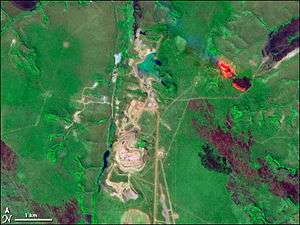Catoca diamond mine
|
Satellite image of the mine from June 21st, 2001. The light red point in the north-east of the mine is a bush fire. | |
| Location | |
|---|---|
 Catoca diamond mine Location in Angola | |
| Country | Angola |
| Coordinates | 09°23′56″S 020°18′03″E / 9.39889°S 20.30083°ECoordinates: 09°23′56″S 020°18′03″E / 9.39889°S 20.30083°E |
| Production | |
| Products | Diamonds (2.6 million carats in 2001) |
| Owner | |
| Company |
Alrosa (32.8%) Endiama (32.8%) Odebrecht (16.4%) Diamond Finance CY BV Group (16.8%) |
The Catoca diamond mine is the fourth largest diamond mine in the world, and is located in Angola. The mine is owned by a consortium of international mining interests, including Endiama (the state mining company of Angola) (32.8% ownership), Alrosa of Russia (32.8%), Odebrecht of Brazil (16.4%), and the Diamond Finance CY BV Group (16.8%). The mine is located on a kimberlite pipe.
Production
The mine had production of 1.8 million carats (360 kg) in 2000 and 2.6 million carats (520 kg) in 2001. Catoca management has been actively expanding capacity at the mine, such that the owners plan to extract as much as 5 million carats (1,000 kg) in 2005. The mine's production is 35% gem quality, compared to a global average of 20%; the diamonds produced at Catoca have an average value of $75 to $100 USD per carat (375 to 500 $/g). Estimated reserves are 60 million carats (12,000 kg).
The diamonds from Catoca Mining Society topped the sales of 2009, with a net profit of 70 million US Dollar, resulting from a gross production of 122.6 million US Dollar, Angop. The information is contained in an annual report from the company released in September 2011. According to the source, the sales reached 7.050.521 carat, at the average rate of 62.23 US Dollar, a volume that represented about 78 percent of the amount sold by the diamond companies around the country. The note states that as a result of the processing of the ore, the company obtained a total of 7.5 million carat that permitted to establish the operational costs.
In 2012 the mine produced 6.5 million carats out of 10 million metric tons of ore production.[1]
Geology
Geologically, the Catoca kimberlite pipe is among the world’s largest primary diamond deposits. The Catoca volcanic edifice is only slightly eroded. Kimberlitic rocks of various facies compose a crater of about 1 km in diameter and a diatreme. The structure of the pipe and mining conditions of the deposit are complicated by intense intrapipe tectonic processes related to large-amplitude subsidence. Based on geological data, we propose a structural model of the deposit and a paleovolcanological model of the Catoca pipe formed during a full cycle beginning with a stage of active volcanism and completed by stages of gradually waning volcanic activity and sedimentation. It is suggested that the banded tuffisitic kimberlite of the crater zone was deposited at the stage of active volcanic eruption from specific pyroclastic suspension as a low-viscosity mixture of crystals and aqueous sol rich in serpentine.[2]
References
- ↑ McClelland, Colin. "Angola's Catoca Diamond Complex to Add Mill as Miners Dig Deeper". Bloomberg. Retrieved 2014-05-20.
- ↑ Pervov, V. A., Somov, S. V., Korshunov, A. V., Dulapchii, E. V., & Félix, J. T. (2011). The Catoca kimberlite pipe, Republic of Angola: A paleovolcanological model. Geology of Ore Deposits, 53(4), 295-308.
